You have an Azure Active Directory (Azure AD) tenant named adatum.com that contains the users shown in the following table.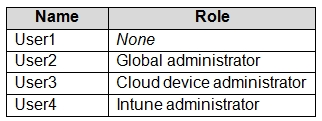
Adatum.com has the following configurations:
✑ Users may join devices to Azure AD is set to User1.
✑ Additional local administrators on Azure AD joined devices is set to None.
You deploy Windows 10 to a computer named Computer1. User1 joins Computer1 to adatum.com.
You need to identify the local Administrator group membership on Computer1.
Which users are members of the local Administrators group?
Answer:
C
Users may join devices to Azure AD - This setting enables you to select the users who can register their devices as Azure AD joined devices. The default is All.
Additional local administrators on Azure AD joined devices - You can select the users that are granted local administrator rights on a device. Users added here are added to the Device Administrators role in Azure AD. Global administrators, here User2, in Azure AD and device owners are granted local administrator rights by default.
Reference:
https://docs.microsoft.com/en-us/azure/active-directory/devices/device-management-azure-portal
HOTSPOT -
You have Azure subscriptions named Subscription1 and Subscription2.
Subscription1 has following resource groups:
RG1 includes a web app named App1 in the West Europe location.
Subscription2 contains the following resource groups:
For each of the following statements, select Yes if the statement is true. Otherwise, select No.
NOTE: Each correct selection is worth one point.
Hot Area: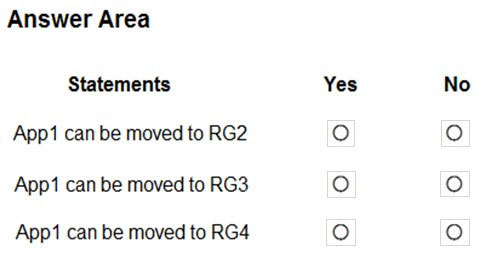
Answer:
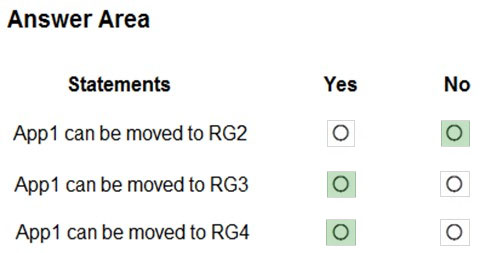
Box 1: No -
RG2 is read only. ReadOnly means authorized users can read a resource, but they cannot delete or update the resource.
Box 2: Yes -
Box 3: Yes -
Note:
App Service resources are region-specific and cannot be moved directly across regions. You can move the App Service resource by creating a copy of your existing App Service resource in the target region, then move your content over to the new app. You can then delete the source app and App Service plan.
To make copying your app easier, you can clone an individual App Service app into an App Service plan in another region.
Reference:
https://docs.microsoft.com/en-us/azure/app-service/manage-move-across-regions https://docs.microsoft.com/en-us/azure/azure-resource-manager/management/move-limitations/app-service-move-limitations
HOTSPOT -
You have an Azure subscription named Subscription1 that contains the following resource group:
✑ Name: RG1
✑ Region: West US
✑ Tag: `tag1`: `value1`
You assign an Azure policy named Policy1 to Subscription1 by using the following configurations:
✑ Exclusions: None
✑ Policy definition: Append a tag and its value to resources
✑ Assignment name: Policy1
✑ Parameters:
✑ Tag name: tag2
Tag value: value2 -
After Policy1 is assigned, you create a storage account that has the following configuration:
✑ Name: storage1
✑ Location: West US
✑ Resource group: RG1
✑ Tags: `tag3`: `value3`
You need to identify which tags are assigned to each resource.
What should you identify? To answer, select the appropriate options in the answer area.
NOTE: Each correct selection is worth one point.
Hot Area: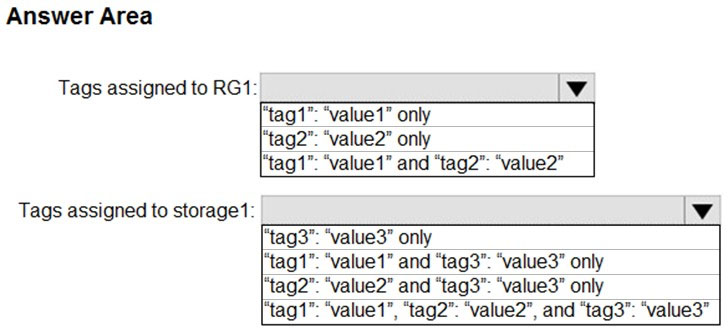
Answer:
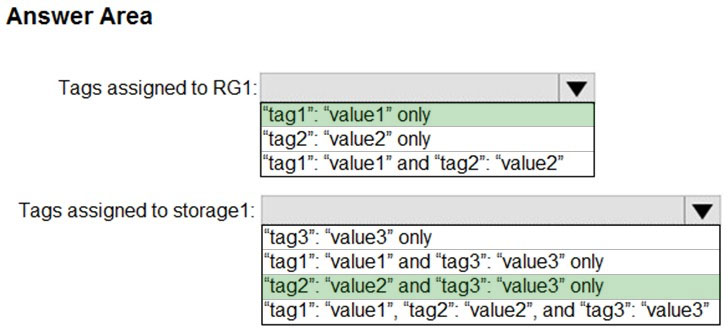
Box 1: "tag1": "value1" only -
Box 2: "tag2": "value2" and "tag3": "value3" only
Tags applied to the resource group are not inherited by the resources in that resource group.
Reference:
https://docs.microsoft.com/en-us/azure/azure-resource-manager/resource-group-using-tags
HOTSPOT -
You have an Azure subscription named Subscription1.
In Subscription1, you create an alert rule named Alert1.
The Alert1 action group is configured as shown in the following exhibit.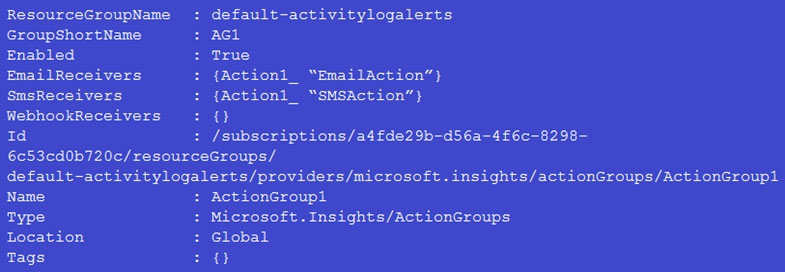
Alert1 alert criteria triggered every minute.
Use the drop-down menus to select the answer choice that completes each statement based on the information presented in the graphic.
NOTE: Each correct selection is worth one point.
Hot Area: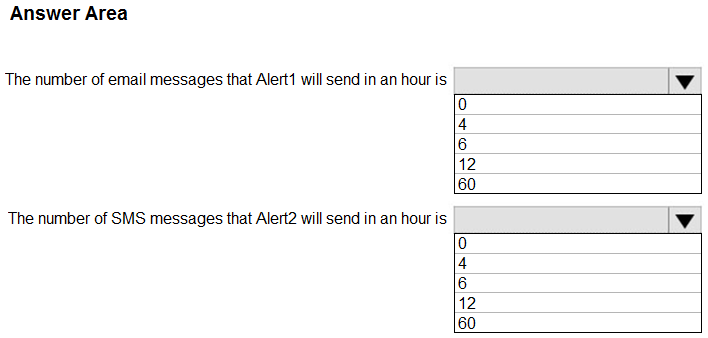
Answer:
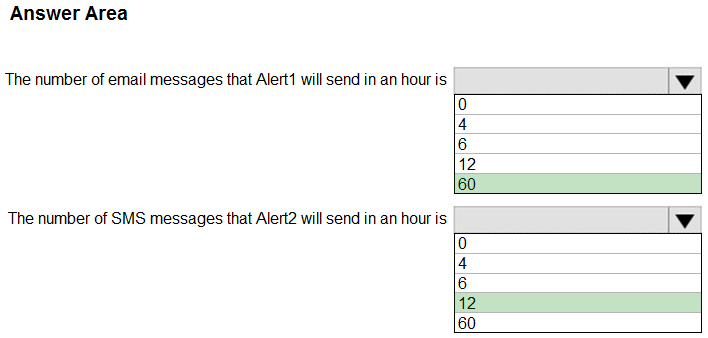
Box 1: 60 -
One alert per minute will trigger one email per minute.
Box 2: 12 -
No more than 1 SMS every 5 minutes can be send, which equals 12 per hour.
Note: Rate limiting is a suspension of notifications that occurs when too many are sent to a particular phone number, email address or device. Rate limiting ensures that alerts are manageable and actionable.
The rate limit thresholds are:
✑ SMS: No more than 1 SMS every 5 minutes.
✑ Voice: No more than 1 Voice call every 5 minutes.
✑ Email: No more than 100 emails in an hour.
✑ Other actions are not rate limited.
Reference:
https://docs.microsoft.com/en-us/azure/azure-monitor/platform/alerts-rate-limiting
You have an Azure subscription named Subscription1 that contains the resources shown in the following table.
You create virtual machines in Subscription1 as shown in the following table.
You plan to use Vault1 for the backup of as many virtual machines as possible.
Which virtual machines can be backed up to Vault1?
Answer:
D
To create a vault to protect virtual machines, the vault must be in the same region as the virtual machines. If you have virtual machines in several regions, create a
Recovery Services vault in each region.
Reference:
https://docs.microsoft.com/bs-cyrl-ba/azure/backup/backup-create-rs-vault
You have an Azure Kubernetes Service (AKS) cluster named AKS1.
You need to configure cluster autoscaler for AKS1.
Which two tools should you use? Each correct answer presents a complete solution.
NOTE: Each correct selection is worth one point.
Answer:
AB
A: The following example uses the kubectl autoscale command to autoscale the number of pods in the azure-vote-front deployment. If average CPU utilization across all pods exceeds 50% of their requested usage, the autoscaler increases the pods up to a maximum of 10 instances. A minimum of 3 instances is then defined for the deployment: kubectl autoscale deployment azure-vote-front --cpu-percent=50 --min=3 --max=10
B: Use the az aks update command to enable and configure the cluster autoscaler on the node pool for the existing cluster.
Reference:
https://docs.microsoft.com/en-us/azure/aks/tutorial-kubernetes-scale https://docs.microsoft.com/en-us/azure/aks/cluster-autoscaler
You create the following resources in an Azure subscription:
✑ An Azure Container Registry instance named Registry1
✑ An Azure Kubernetes Service (AKS) cluster named Cluster1
You create a container image named App1 on your administrative workstation.
You need to deploy App1 to Cluster1.
What should you do first?
Answer:
C
You should sign in and push a container image to Container Registry.
Run the az acr build command to build and push the container image. az acr build \
--image contoso-website \
--registry $ACR_NAME \
--file Dockerfile .
Reference:
https://docs.microsoft.com/en-us/learn/modules/aks-deploy-container-app/5-exercise-deploy-app
You have an Azure subscription that contains the resources shown in the following table.
You need to configure a proximity placement group for VMSS1.
Which proximity placement groups should you use?
Answer:
A
Resource Group location of VMSS1 is the RG2 location, which is West US.
Only Proximity2, which also in RG2, is location in West US
Reference:
https://azure.microsoft.com/en-us/blog/introducing-proximity-placement-groups/
Note: This question is part of a series of questions that present the same scenario. Each question in the series contains a unique solution that might meet the stated goals. Some question sets might have more than one correct solution, while others might not have a correct solution.
After you answer a question in this section, you will NOT be able to return to it. As a result, these questions will not appear in the review screen.
You have an Azure subscription named Subscription1. Subscription1 contains a resource group named RG1. RG1 contains resources that were deployed by using templates.
You need to view the date and time when the resources were created in RG1.
Solution: From the Subscriptions blade, you select the subscription, and then click Resource providers.
Does this meet the goal?
Answer:
B
Note: This question is part of a series of questions that present the same scenario. Each question in the series contains a unique solution that might meet the stated goals. Some question sets might have more than one correct solution, while others might not have a correct solution.
After you answer a question in this section, you will NOT be able to return to it. As a result, these questions will not appear in the review screen.
You have an Azure subscription named Subscription1. Subscription1 contains a resource group named RG1. RG1 contains resources that were deployed by using templates.
You need to view the date and time when the resources were created in RG1.
Solution: From the RG1 blade, you click Automation script.
Does this meet the goal?
Answer:
B
From the RG1 blade, click Deployments. You see a history of deployment for the resource group.
Reference:
https://docs.microsoft.com/en-us/azure/azure-resource-manager/templates/template-tutorial-create-first-template?tabs=azure-powershell